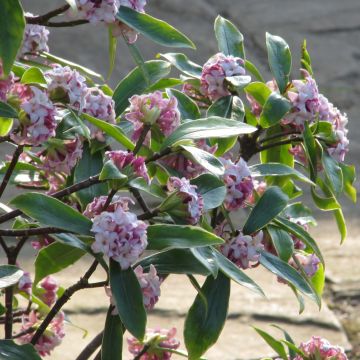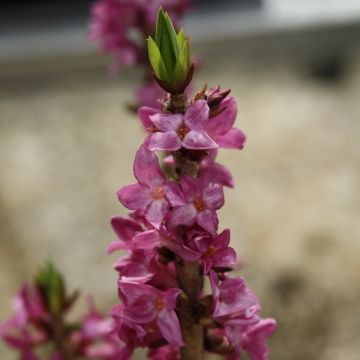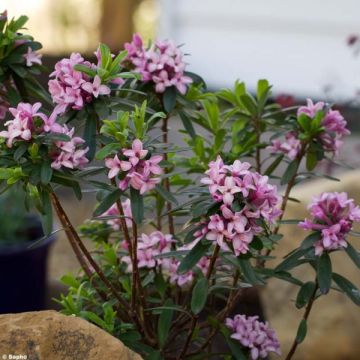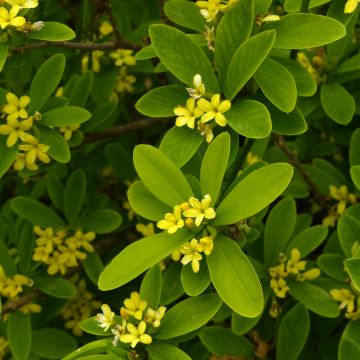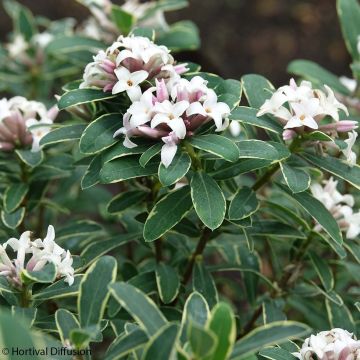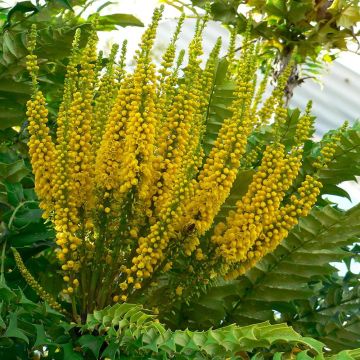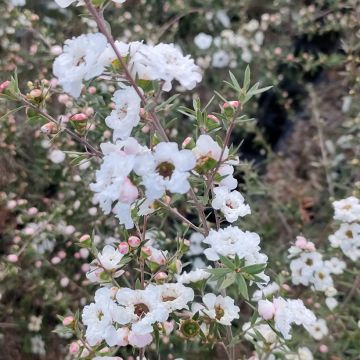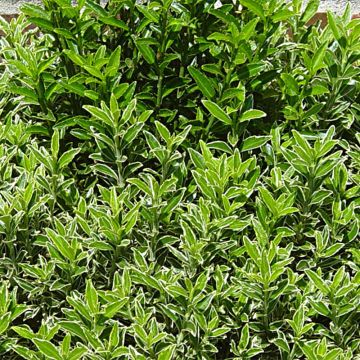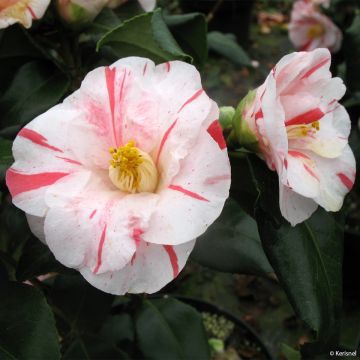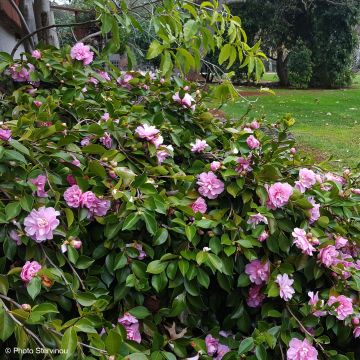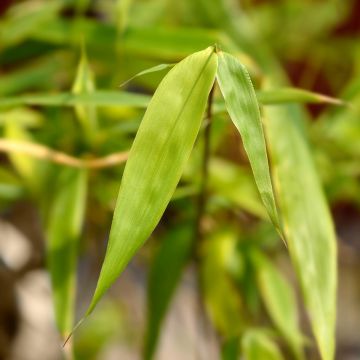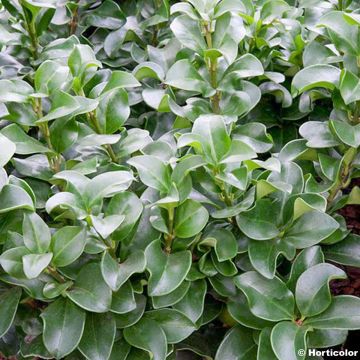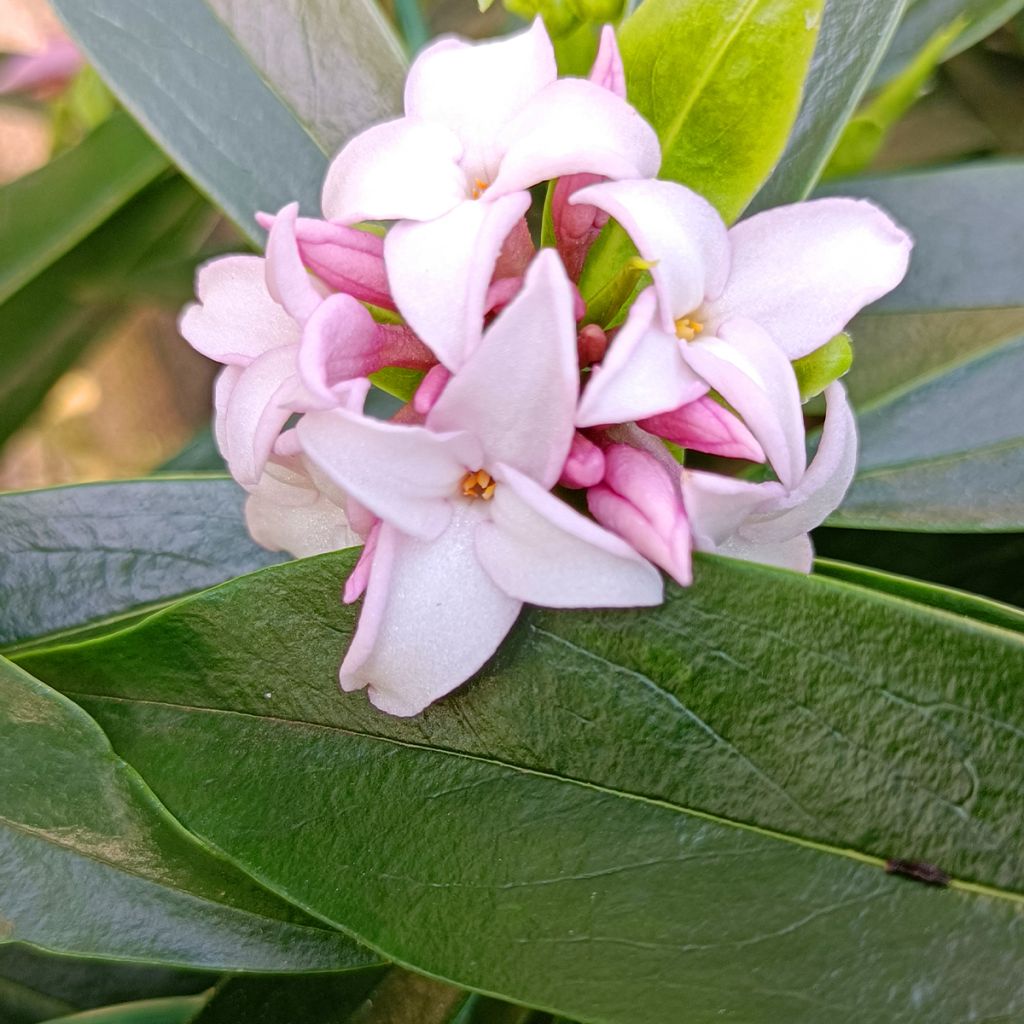

Daphne Perfume Princess
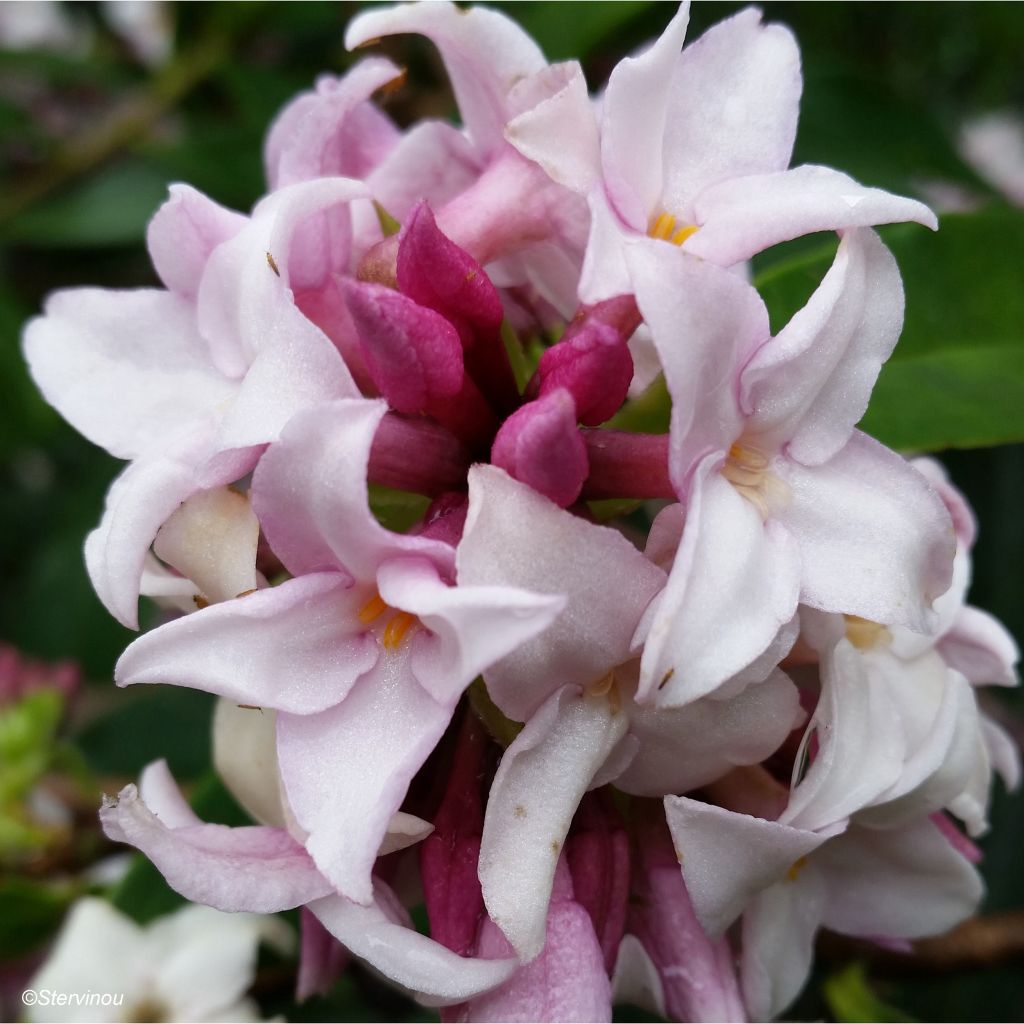

Daphne Perfume Princess
Daphne Perfume Princess
Daphne odora x bholua Perfume Princess® 'DapJur01'
Winter daphne, Fragrant daphne
Why not try an alternative variety in stock?
View all →This plant carries a 24 months recovery warranty
More information
We guarantee the quality of our plants for a full growing cycle, and will replace at our expense any plant that fails to recover under normal climatic and planting conditions.
From €5.90 for pickup delivery and €6.90 for home delivery
Express home delivery from €8.90.
From €5.90 for pickup delivery and €6.90 for home delivery
Express home delivery from €8.90.

Does this plant fit my garden?
Set up your Plantfit profile →
Description
Daphne 'Perfume Princess' owes its name to its large clusters of delicately pink, beautifully scented flowers, capable of perfuming a whole area of the garden from the end of winter, and again in summer. This new hybrid from the antipodes is undoubtedly the earliest and most floriferous of all daphne hybrids. This evergreen shrub is adorned with generous clusters of pink and then white flowers, which bloom along the branches, at the axil of large dark green evergreen leaves, which are also very ornamental. 'Perfume Princess' is an exceptional shrub, both hardy and less demanding than a rhododendron. Floriferous, highly ornamental and fragrant; these qualities should make this variety the new star of gardens and terraces.
Daphne 'Perfume Princess' is a shrub belonging to the Thymelaeaceae family, a cousin of the "Bois joli" and "Garou". This new hybrid from New Zealand is the result of cross-breeding between D. odora, a Chinese evergreen shrub that is not very hardy, and Daphne bholua, a tall upright shrub native to the eastern Himalayas, also highly fragrant but much hardier. 'Perfume Princess' forms an upright, bushy shrub, 1.2 m (3 ft 11 in) tall and 90 cm (35.4 in) wide at maturity. Its growth is quite slow. Very floriferous, it is adorned from March-April with delicate, very fragrant star-shaped flowers that are pink with orange anthers, sometimes reaching 6 cm (2.4 in) in diameter, gathered in large umbels. A well-established plant will produce up to 10 clusters of flowers on each branch, spread from its base to its tip. This exceptional flowering period is followed by a resting period in July-August, before it blooms again in late summer, so that this daphne is in bloom for about six months of the year. Its complex fragrance, both sweet and rustic, recalls carnation, jasmine, hyacinth, enhanced with a spicy hint of clove and lemony notes. The large entire lanceolate dark green coriaceous leaves are 6 to 10 cm (2.4 to 3.9 in) long and 1 to 2.5 cm (0.4 to 1 in) wide. They are grouped in tufts at the top of the branches and then spread along the entire length of the year's stems. They are evergreen in mild and temperate climates, but often semi-evergreen in cold climates. This variety does not require pruning and shows some resistance to diseases.
The 'Perfume Princess' hybrid Daphne is hardy and not very fussy about the nature of the soil, as long as it is properly drained, rather moist and not excessively limestone. It can be used in flower beds, as a standalone plant or in large pots, and tolerates sunny exposures very well. To enjoy its exceptional flowering and fragrance, it is wise to plant it near a window, a pathway or an entrance. It is perfect in an ericaceous flower bed, alongside autumn camellias, deciduous azaleas and hydrangeas. Its flowering branches are also beautiful in bouquets, mixed with those of Japanese quince or Prunus.
Note: Daphnes are sometimes temperamental plants, and their cultivation can be delicate if the conditions are not suitable. They are best reserved for experienced gardeners.
Report an error about the product description
Daphne Perfume Princess in pictures
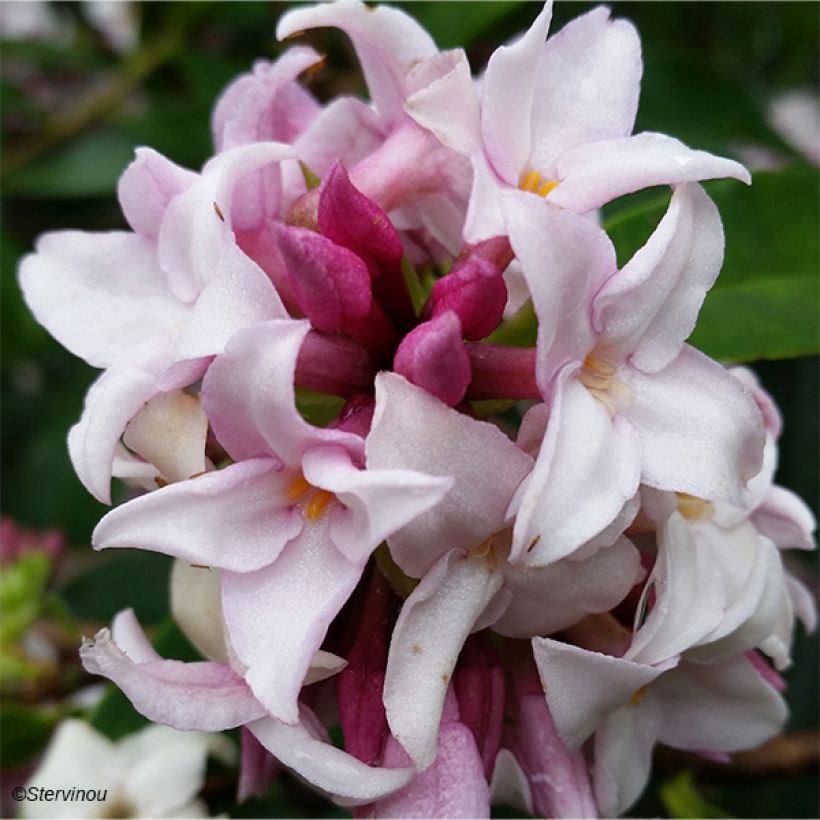

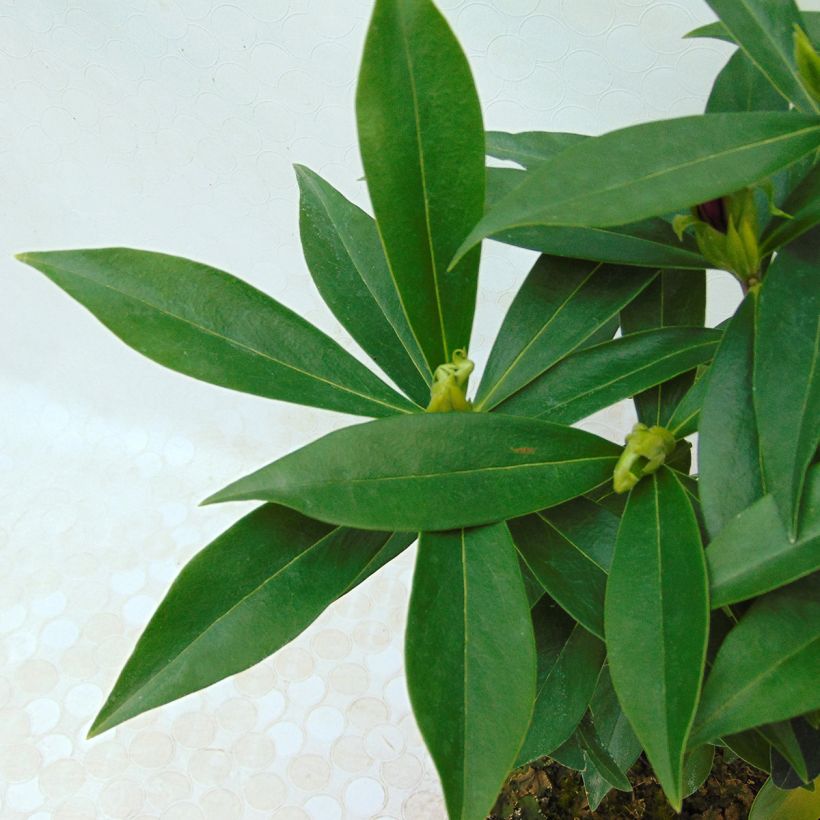

Plant habit
Flowering
Foliage
Safety measures
Botanical data
Daphne
odora x bholua
Perfume Princess® 'DapJur01'
Thymelaceae
Winter daphne, Fragrant daphne
Cultivar or hybrid
ingestion
Cette plante est toxique si elle est ingérée volontairement ou involontairement.
Ne la plantez pas là où de jeunes enfants peuvent évoluer, et lavez-vous les mains après l'avoir manipulée.
Pensez à conserver l'étiquette de la plante, à la photographier ou à noter son nom, afin de faciliter le travail des professionnels de santé.
Davantage d'informations sur https://plantes-risque.info
Other Daphne
Planting and care
The Pink Perfume Daphne should be planted in spring or autumn in a fresh, fertile, light and well-drained soil that is neutral or slightly acidic, without too much limestone. It appreciates a sunny to semi-shaded exposure and can withstand temperatures as low as -15 °C (5 °F). Pruning is unnecessary except for dead branches. Do not let the soil dry out: apply an organic mulch or plant small perennials to protect the base. Avoid disturbing the roots since the plant will not appreciate this at all. After flowering, apply an organic fertiliser. Like Daphne odora, it can sometimes be affected by the Marssonina virus; treat it with a fungicidal in spring.
Planting period
Intended location
Care
-
, onOrder confirmed
Reply from on Promesse de fleurs
Evergreen shrubs
Haven't found what you were looking for?
Hardiness is the lowest winter temperature a plant can endure without suffering serious damage or even dying. However, hardiness is affected by location (a sheltered area, such as a patio), protection (winter cover) and soil type (hardiness is improved by well-drained soil).

Photo Sharing Terms & Conditions
In order to encourage gardeners to interact and share their experiences, Promesse de fleurs offers various media enabling content to be uploaded onto its Site - in particular via the ‘Photo sharing’ module.
The User agrees to refrain from:
- Posting any content that is illegal, prejudicial, insulting, racist, inciteful to hatred, revisionist, contrary to public decency, that infringes on privacy or on the privacy rights of third parties, in particular the publicity rights of persons and goods, intellectual property rights, or the right to privacy.
- Submitting content on behalf of a third party;
- Impersonate the identity of a third party and/or publish any personal information about a third party;
In general, the User undertakes to refrain from any unethical behaviour.
All Content (in particular text, comments, files, images, photos, videos, creative works, etc.), which may be subject to property or intellectual property rights, image or other private rights, shall remain the property of the User, subject to the limited rights granted by the terms of the licence granted by Promesse de fleurs as stated below. Users are at liberty to publish or not to publish such Content on the Site, notably via the ‘Photo Sharing’ facility, and accept that this Content shall be made public and freely accessible, notably on the Internet.
Users further acknowledge, undertake to have ,and guarantee that they hold all necessary rights and permissions to publish such material on the Site, in particular with regard to the legislation in force pertaining to any privacy, property, intellectual property, image, or contractual rights, or rights of any other nature. By publishing such Content on the Site, Users acknowledge accepting full liability as publishers of the Content within the meaning of the law, and grant Promesse de fleurs, free of charge, an inclusive, worldwide licence for the said Content for the entire duration of its publication, including all reproduction, representation, up/downloading, displaying, performing, transmission, and storage rights.
Users also grant permission for their name to be linked to the Content and accept that this link may not always be made available.
By engaging in posting material, Users consent to their Content becoming automatically accessible on the Internet, in particular on other sites and/or blogs and/or web pages of the Promesse de fleurs site, including in particular social pages and the Promesse de fleurs catalogue.
Users may secure the removal of entrusted content free of charge by issuing a simple request via our contact form.
The flowering period indicated on our website applies to countries and regions located in USDA zone 8 (France, the United Kingdom, Ireland, the Netherlands, etc.)
It will vary according to where you live:
- In zones 9 to 10 (Italy, Spain, Greece, etc.), flowering will occur about 2 to 4 weeks earlier.
- In zones 6 to 7 (Germany, Poland, Slovenia, and lower mountainous regions), flowering will be delayed by 2 to 3 weeks.
- In zone 5 (Central Europe, Scandinavia), blooming will be delayed by 3 to 5 weeks.
In temperate climates, pruning of spring-flowering shrubs (forsythia, spireas, etc.) should be done just after flowering.
Pruning of summer-flowering shrubs (Indian Lilac, Perovskia, etc.) can be done in winter or spring.
In cold regions as well as with frost-sensitive plants, avoid pruning too early when severe frosts may still occur.
The planting period indicated on our website applies to countries and regions located in USDA zone 8 (France, United Kingdom, Ireland, Netherlands).
It will vary according to where you live:
- In Mediterranean zones (Marseille, Madrid, Milan, etc.), autumn and winter are the best planting periods.
- In continental zones (Strasbourg, Munich, Vienna, etc.), delay planting by 2 to 3 weeks in spring and bring it forward by 2 to 4 weeks in autumn.
- In mountainous regions (the Alps, Pyrenees, Carpathians, etc.), it is best to plant in late spring (May-June) or late summer (August-September).
The harvesting period indicated on our website applies to countries and regions in USDA zone 8 (France, England, Ireland, the Netherlands).
In colder areas (Scandinavia, Poland, Austria...) fruit and vegetable harvests are likely to be delayed by 3-4 weeks.
In warmer areas (Italy, Spain, Greece, etc.), harvesting will probably take place earlier, depending on weather conditions.
The sowing periods indicated on our website apply to countries and regions within USDA Zone 8 (France, UK, Ireland, Netherlands).
In colder areas (Scandinavia, Poland, Austria...), delay any outdoor sowing by 3-4 weeks, or sow under glass.
In warmer climes (Italy, Spain, Greece, etc.), bring outdoor sowing forward by a few weeks.

































